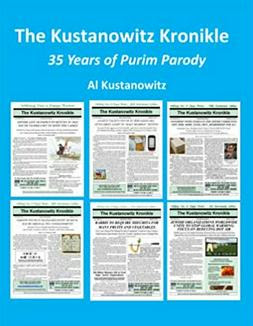Hava Nagila, that old musical standby, the song that used to be played at every Jewish gathering, is increasingly becoming musica non grata at weddings, bar and bat mitzvahs, and other festive occasions.
As simchas, or joyous affairs, include longer dance sets playing a variety of Hebrew music, Hava Nagila is rarely played, unless it's a special request from the hosts or guests. The song is becoming an unwelcome cliche among those who listen to a lot of Hebrew music.
Its popularity hasn't diminished in circles where it's played as the token Jewish dance at events where most of the music is American pop and rock. And it remains an iconic symbol of Jewish life as seen in an upcoming exhibit at the Museum of Jewish Heritage and in a documentary that premiered last week at the San Francisco Jewish Film Festival.
Since starting Jewish Humor Central almost three years ago, we have shared 21 videos of traditional and off-beat versions of Hava Nagila showing up in such places as India, Estonia, Korea, Italy, Russia, Paraguay, Peru, Thailand, and the Shetland Islands. And we're not done. You can expect to see more examples of this enduring song performed in still more unexpected places.
Yesterday's Wall Street Journal carried a front page report about the backlash. As Lucette Lagnado reported,
"Hava Nagila," Hebrew for "Let Us Rejoice," has been a staple of Jewish—and some non-Jewish—celebrations for decades. The song often accompanies the hora, a traditional dance-in-the-round that is performed at weddings, bar mitzvahs, engagement parties and other joyful occasions.
As American Jews assimilated, "Hava Nagila," with its dizzying tune that incorporates major and minor modes, became one of the last cultural touchstones of the past. Even the most secular Jews craved it.
It became "the equivalent of a knish," says Henry Sapoznik, an ethnomusicologist at the University of Wisconsin. Incidentally, he considers it to be "a really crummy little tune."
Crummy or not, the melody rang off the walls of catering halls, echoed in big suburban synagogues that sprouted up after World War II and broke into the musical mainstream in the 1950s. Crooner Harry Belafonte made it one of his signature songs. Chubby Checker danced the twist to it. Lena Horne used the melody to deliver a powerful message against racism in a song called "Now." In 1961, Bob Dylan sang his own version—"Talkin' Hava Nageilah Blues"—in a Greenwich Village club.
Some of those earlier interpretations may have boosted "Hava Nagila" into an improbably cool range. Now, a backlash is in full swing.
"It is the cliché of Jewish music," insists Neshoma Orchestra leader Elly Zomick, which does some 200 wedding and bar mitzvah gigs a year. He avoids playing it—along with "The Macarena," "YMCA," and "Sunrise, Sunset"—unless specifically asked.
Among other tunes from the annoyingly redundant banquet-hall repertoire: "The Electric Slide" and the "Chicken Dance."
Rabbi Haskel Lookstein of Kehilath Jeshurun, a large Orthodox congregation on Manhattan's Upper East Side, isn't one to be moved. The body of Jewish musical works, he says, "has gone leagues beyond" the familiar ditties. Yet "no one sings it unless someone in the wedding party has a nostalgia for the old days."
The Journal has posted a video about the worldwide popularity of the song that surprisingly omits any reference to the backlash reported in the front page article. But it's a nice piece of nostalgia that's worth seeing. Enjoy!
(A SPECIAL NOTE FOR NEW EMAIL SUBSCRIBERS:
THE VIDEO MAY NOT BE VIEWABLE DIRECTLY
FROM THE EMAIL THAT YOU GET EACH DAY ON
SOME COMPUTERS AND TABLETS. YOU MUST CLICK ON THE TITLE AT
THE TOP OF THE EMAIL TO REACH THE JEWISH HUMOR
CENTRAL WEBSITE, FROM WHICH YOU CLICK ON THE
PLAY BUTTON IN THE VIDEO IMAGE TO START THE
VIDEO.)















No comments:
Post a Comment